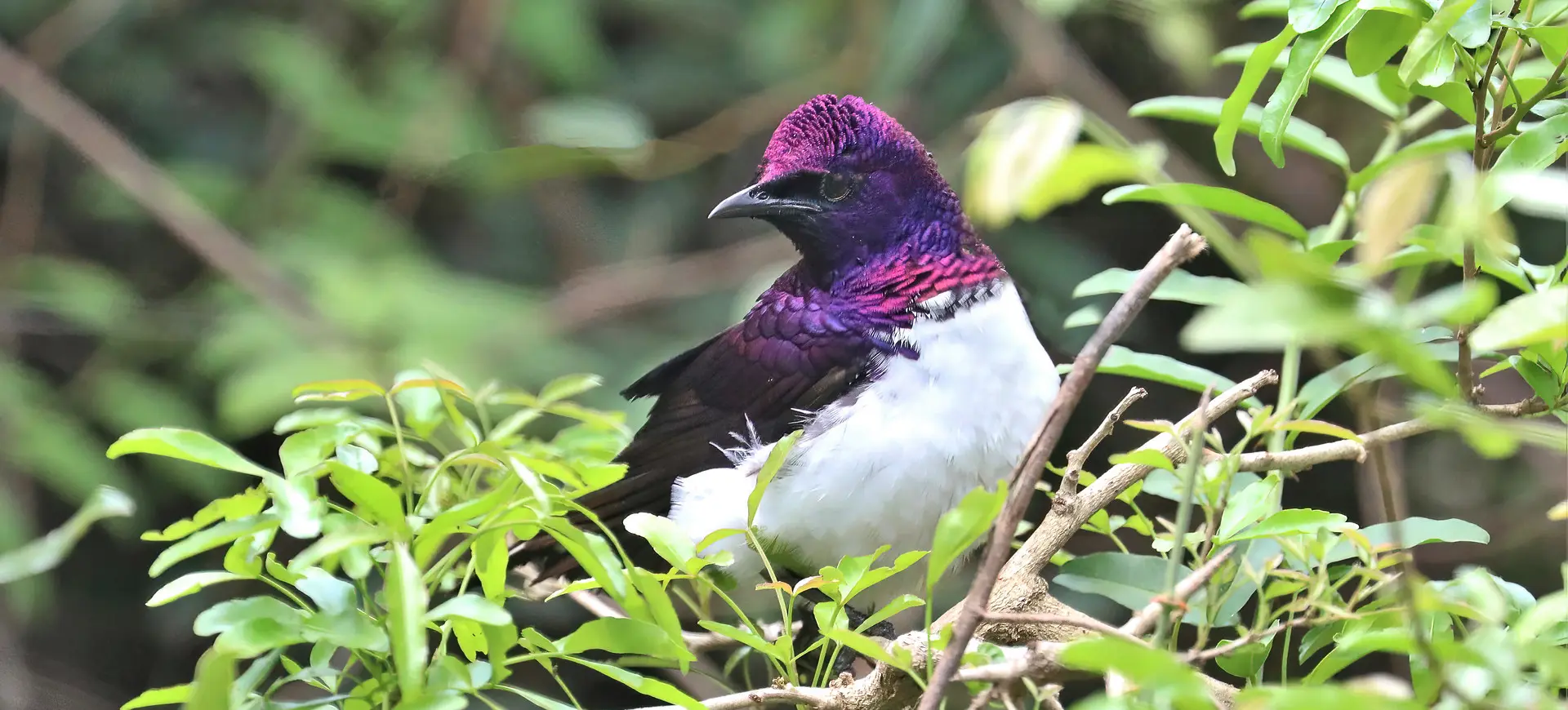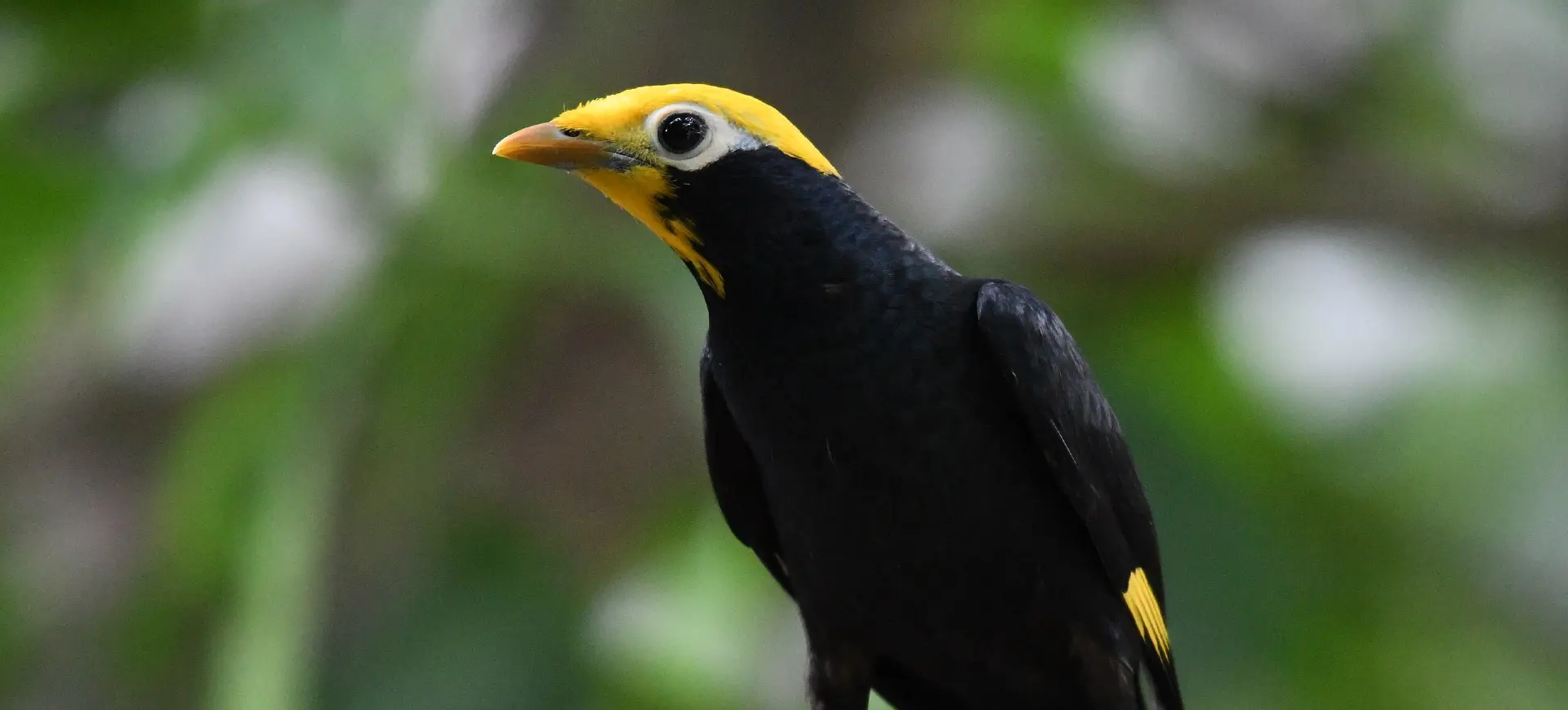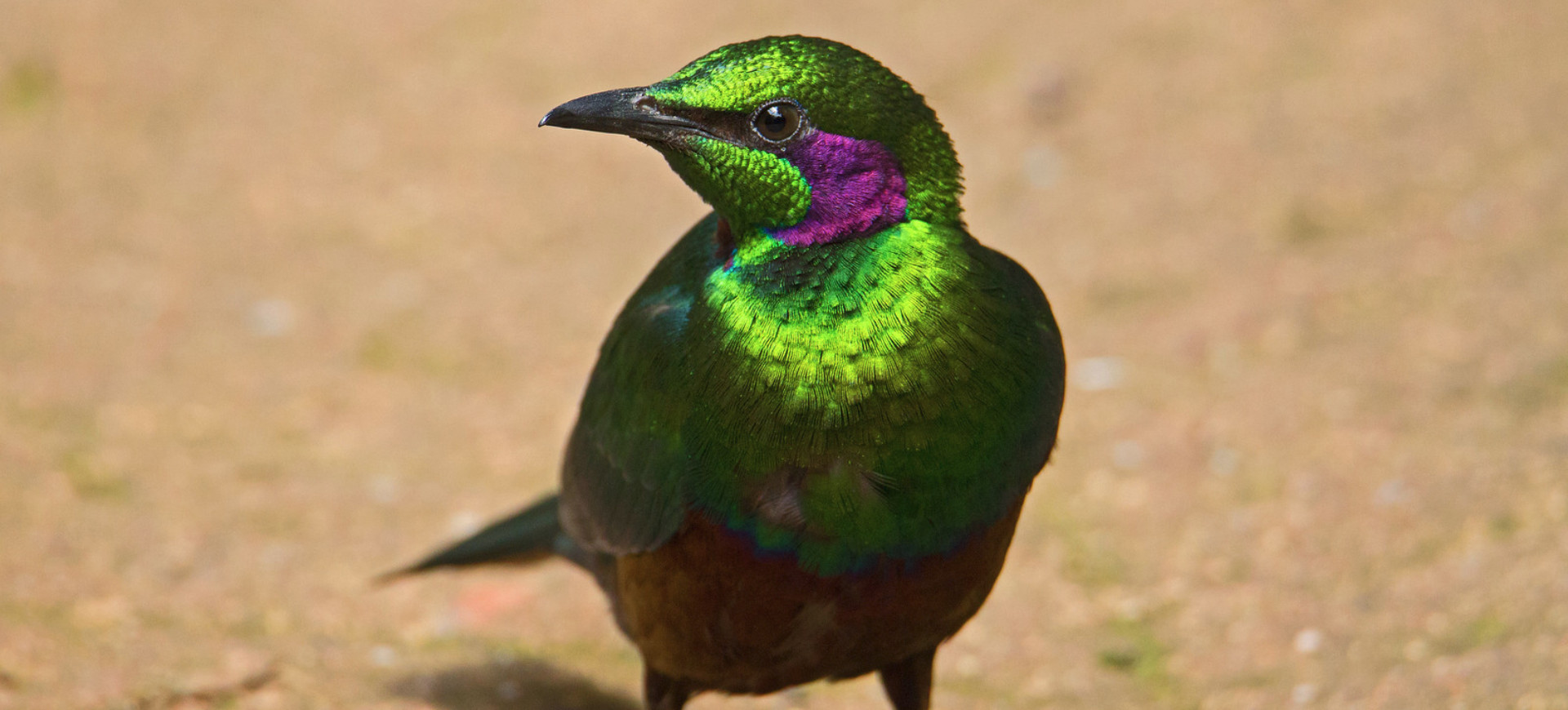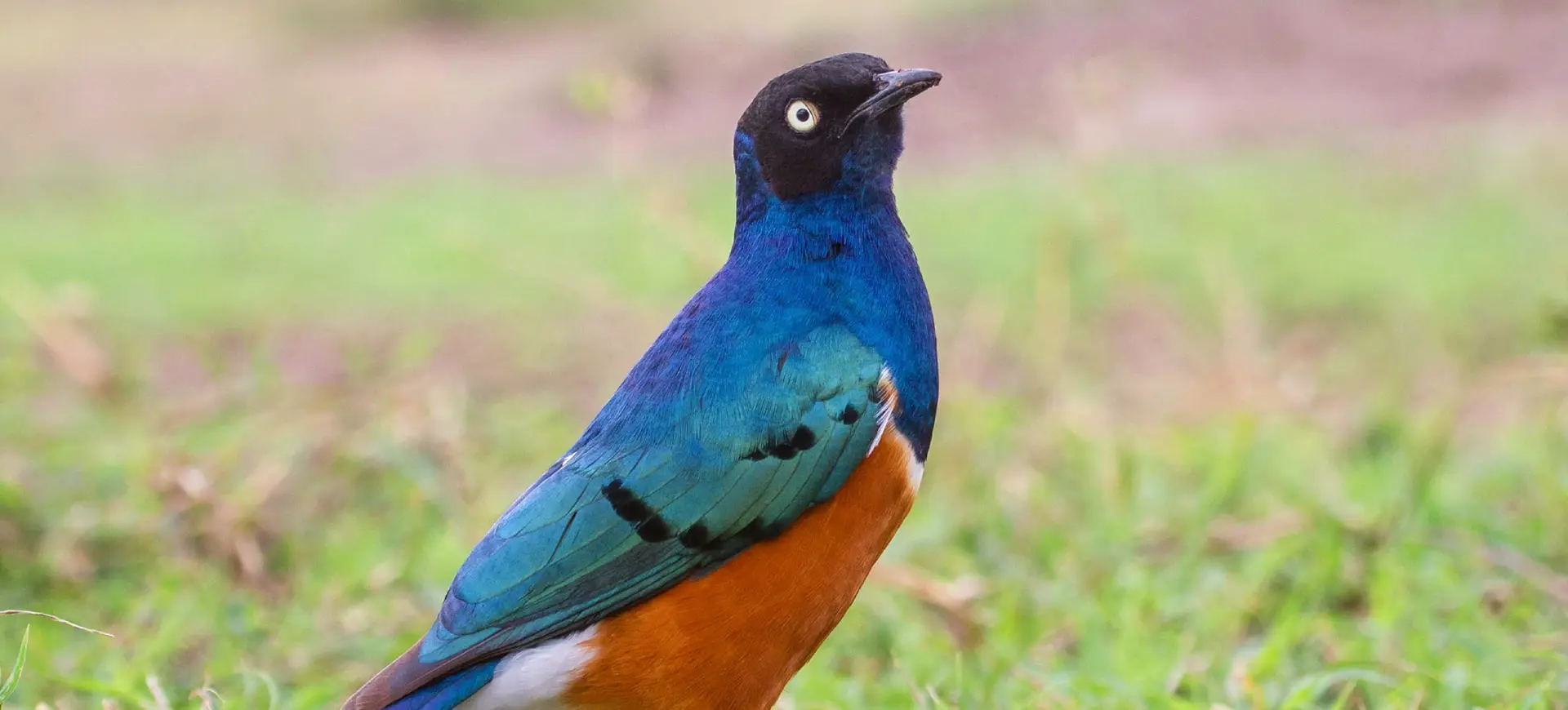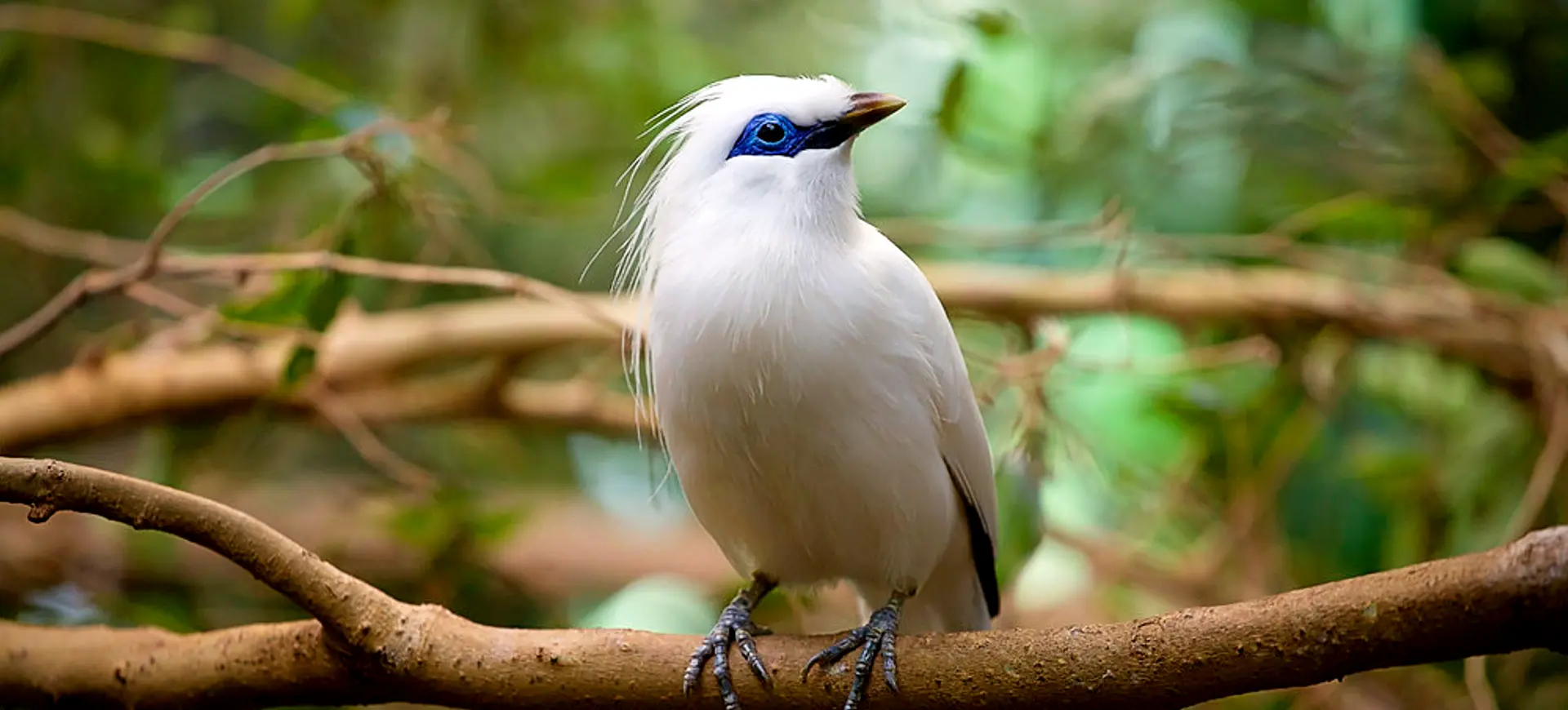Overview
The Metallic Starling (Aplonis metallica) is a striking bird renowned for its iridescent black plumage that gleams with metallic hues of green and purple in sunlight. Native to the tropical regions of Australia, Papua New Guinea, and nearby islands, this species exhibits a slender body, a sharp, pointed beak, and a relatively long tail that contributes to its graceful flight. The adult Metallic Starling is easily identifiable by its bright red eyes, which contrast vividly against its glossy feathers. These birds are highly social and gregarious, often found in large flocks that can number in the thousands, especially during the breeding season.
Metallic Starlings are known for their complex, communal nesting structures, built high in the canopies of rainforest trees. These nests are impressive, sometimes housing multiple families within a single structure, showcasing the bird’s cooperative breeding behavior. Their diet is predominantly frugivorous, consisting mainly of fruits, nectar, and the occasional insect, which they forage for in the canopy. The species plays a significant role in seed dispersal and pollination within their ecosystems, highlighting their importance in maintaining healthy forest environments.
The conservation status of the Metallic Starling is currently considered of the least concern, largely due to its wide distribution and large population. However, it is not without threats, as habitat destruction and climate change challenge its natural habitats. Conservation efforts and ongoing research are crucial to ensure the stability of Metallic Starling populations and the preservation of their tropical forest homes.
Taxonomy
Kingdom
Phylum
Class
Order
Family
Genus
Species
Type
Physical Description:
The Metallic Starling is distinguished by its sleek, shimmering plumage, which appears almost liquid under lighting. Adults typically measure about 21 to 25 cm long, making them medium-sized birds within the starling family. Their body is aerodynamically shaped, allowing for agile and swift flight, an adaptation that serves them well in their forested habitats. The stark contrast between their dark feathers and bright red eyes makes them one of the more visually striking species of starlings.
Juvenile Metallic Starlings lack the iridescent plumage of adults, sporting a duller brown color with a hint of the metallic sheen to come as they mature. Both sexes exhibit similar plumage, with little to differentiate males from females in appearance. The bird’s strong, pointed beak is well-suited to its diet, capable of extracting nectar from flowers and grasping fruits. The long legs and claws allow it to maneuver through the branches for food.

Lifespan: Wild: ~8 years || Captivity: ~10 years

Weight: Male & Female: 1.7-2.4 oz (48-67 g)

Length: Male & Female: 8.3-9.8 inches (21-25 cm)

Wingspan: Male & Female: 13–15 inches (31–36 cm)

Top Speed: 20 mph (32 km/h)
Characteristic:
Native Habitat:
The Metallic Starling is native to the tropical regions of Australia, Papua New Guinea, and the adjacent islands, where it inhabits rainforests, mangroves, and woodland areas. These habitats provide the dense canopy cover and abundant fruiting vegetation the species relies on for food and nesting. The bird’s preference for high canopy layers allows it to exploit a niche that reduces resource competition with other forest dwellers.
Adaptation to these environments is evident in the bird’s physical and behavioral traits, designed for life in a complex, three-dimensional forest structure. Conservation of these natural habitats is essential for the survival of the Metallic Starling, highlighting the importance of protecting tropical forests from deforestation and degradation.
Climate Zones:
Biomes:
WWF Biomes:
Biogeographical Realms:
Countries:
Diet:
Diet & Feeding Habits:
Metallic Starlings are primarily frugivores. Their diet includes fruits, berries, and nectar, which they forage in the forest canopy. Their feeding habits play a crucial role in their ecosystems, as they are important seed dispersal and pollination agents. During certain times of the year, they may also consume insects and small invertebrates, adding a source of protein to their diet.
These birds are often observed feeding in large flocks, taking advantage of the abundance of food sources in their habitats. They prefer certain fruiting trees and shrubs, which can lead to frenetic feeding activity when these are in season. The Metallic Starling’s feeding behavior underscores the interconnectedness of tropical forest ecosystems, with the bird contributing to the health and regeneration of its environment.
Mating Behavior:
Mating Description:
Metallic Starlings are known for their remarkable communal nesting behavior, with large colonies coming together to construct elaborate, hanging nests made of twigs and vegetation. These nests are often built near one another in a selected tree, creating a dense aggregation that can number in the hundreds. The breeding season is marked by a flurry of activity, with males displaying aggressively to attract females and defend their nesting territory.
Females lay 2 to 4 eggs per clutch, then incubated for about two weeks before hatching. Both parents share responsibilities for feeding and protecting the nestlings. The communal aspect of their breeding strategy provides safety in numbers from predators and facilitates a high degree of social interaction among colony members. This breeding behavior underscores the complex social structure of the Metallic Starling and its adaptation to life in dense forest environments.
Reproduction Season:
Birth Type:
Pregnancy Duration:
Female Name:
Male Name:
Baby Name:
Social Structure Description:
The Metallic Starling is highly social, forming large flocks that engage in communal roosting and nesting. This gregarious behavior is most evident during breeding when birds come together to construct and maintain large communal nests. The social structure of the Metallic Starling is characterized by complex interactions within the flock, including cooperative breeding, shared defense of nesting sites, and communal foraging.
Social bonds are reinforced through vocalizations and physical displays, facilitating communication and cohesion within the flock. The communal lifestyle of the Metallic Starling provides advantages in terms of predator avoidance and resource utilization, demonstrating the benefits of social living in the animal kingdom. Understanding the social dynamics of this species offers insights into the evolutionary drivers of communal behavior in birds.
Groups:
Conservation Status:
Population Trend:
The population of the Metallic Starling is considered stable across its extensive range, with no immediate threats leading to a decline in numbers. The species benefits from its adaptability to various forest habitats and abundant food sources. Conservation efforts focusing on protecting tropical forests and preventing habitat destruction are vital for ensuring the continued stability of Metallic Starling populations.
Despite its current status as Least Concern, the Metallic Starling’s reliance on dense forest habitats makes it susceptible to deforestation and habitat fragmentation. Ongoing conservation initiatives and habitat management strategies are essential to mitigate these threats and preserve the ecological balance of tropical forest ecosystems where the Metallic Starling and many other species reside.
Population Threats:
The main threats to the Metallic Starling include habitat loss and degradation due to deforestation, land conversion for agriculture, and urban development. These activities reduce the availability of suitable nesting and feeding habitats, potentially impacting the bird’s ability to sustain its population. Climate change also poses a long-term threat, as weather patterns can affect the fruiting cycles of trees and the overall health of forest ecosystems.
Conservation measures that address these threats are crucial for protecting the Metallic Starling and the broader biodiversity of tropical forests. Sustainable land-use practices, reforestation efforts, and the establishment of protected areas are among the strategies that can help preserve the natural habitats of this and other forest-dependent species.
Conservation Efforts:
Conservation efforts for the Metallic Starling focus on habitat preservation and restoring degraded forest areas. Protected areas and national parks play a key role in safeguarding the bird’s habitat, providing sanctuaries where populations can thrive. Environmental organizations and government agencies collaborate on conservation projects that aim to protect tropical forests from deforestation and habitat fragmentation threats.
Education and community engagement initiatives are also important, raising awareness about the importance of forest conservation and the role of species like the Metallic Starling in ecosystem health. Research into the bird’s ecology and habitat requirements further informs conservation planning, ensuring that actions taken are based on scientific understanding of the species’ needs. These combined efforts contribute to conserving the Metallic Starling and the rich biodiversity of tropical forest ecosystems.
Additional Resources:
Fun Facts
- The iridescent plumage of the Metallic Starling changes color depending on the angle of light, creating a dazzling display.
- They are one of the few bird species that build communal nests, which can house hundreds of individuals in a single tree.
- The bright red eyes of the Metallic Starling are highly distinctive and add to their striking appearance.
- Their communal nests are used for breeding and provide shelter during adverse weather conditions.
- The Metallic Starling plays a crucial role in their ecosystems as pollinators and seed dispersers, contributing to forest regeneration.
- Despite their social nature, competition for nesting sites within the colony can be intense, leading to dramatic aerial displays.
- The Metallic Starling’s vocal repertoire includes various chirps, whistles, and mimicry used for communication and mating displays.
- They are capable of rapid, agile flight, which they use to evade predators and catch insects mid-air.
- Metallic Starlings migrate seasonally between breeding and non-breeding areas, showcasing their adaptability to different environments.
- The construction of their large, hanging nests is a remarkable example of avian architecture, involving intricate weaving of twigs and vegetation.





